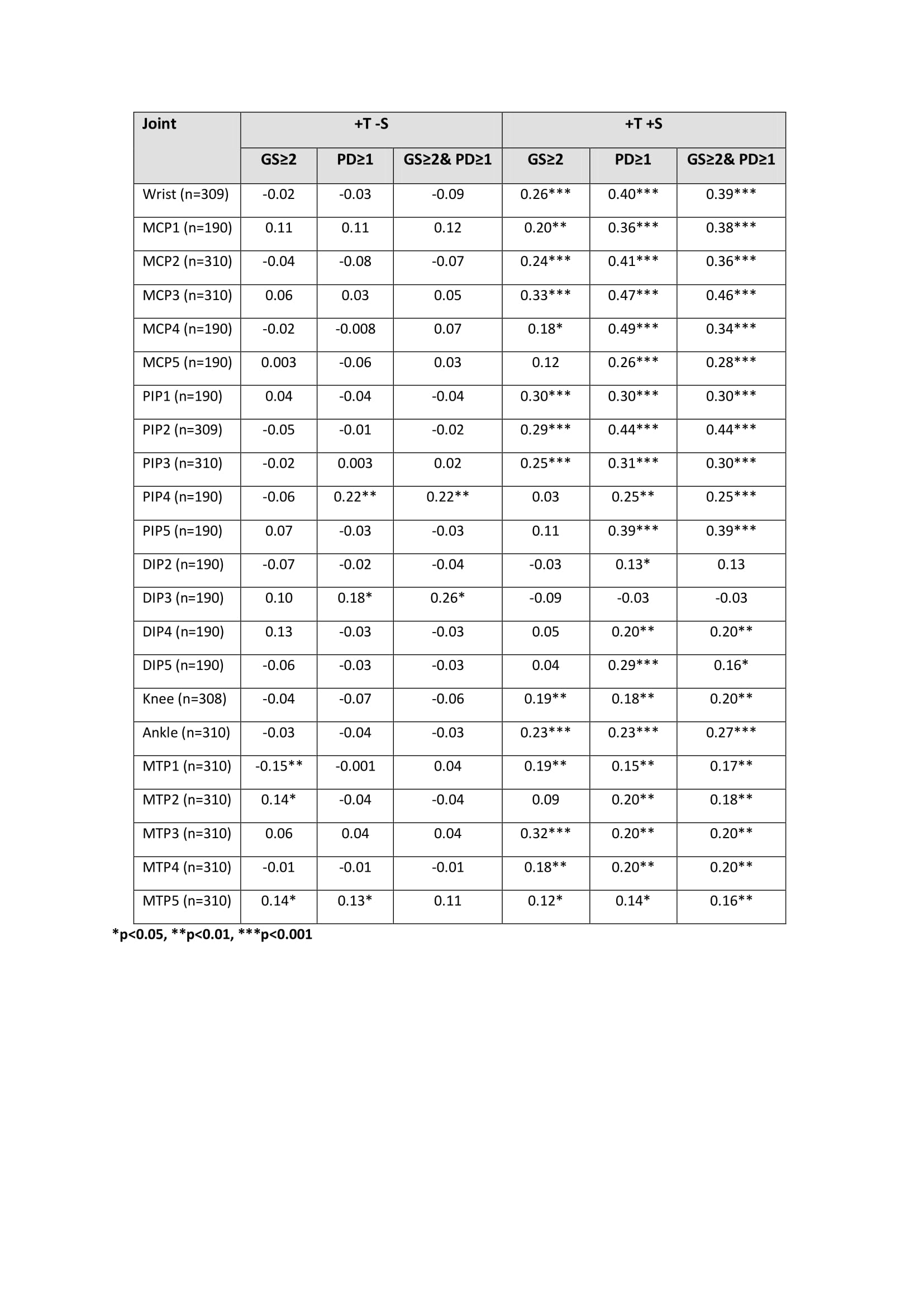Session Information
Date: Friday, November 6, 2020
Session Type: Poster Session A
Session Time: 9:00AM-11:00AM
Background/Purpose: Clinical tender and swollen joint counts are used for biologic drug eligibility and clinical trial inclusion criteria. Ultrasonography (US) adds to clinical examination as it is a sensitive imaging modality in the assessment of inflammatory arthritis, yet its relationship with tender and swollen joints is not fully understood. The objective of this study was to explore the relationship between clinical examination and US determined synovitis in very early, DMARD naïve psoriatic arthritis (PsA).
Methods: Eligible PsA patients determined by CASPAR criteria underwent matched clinical and US joint assessments (44 joints). Disease activity per joint was determined by tender/swollen joints (TJ/SJ) and US synovitis defined by power Doppler (PD) ≥1. Agreement between TJ/SJ and PD≥1 was conducted at the individual joint level and patient level (TJC/SJC). Statistical agreement between clinical and US assessments was calculated using prevalence-adjusted and bias-adjusted kappa (PABAK), and the association was determined using the Spearman’s rank test (rho/ρ).
Results: A total of 5,616 joints were assessed using US in 155 patients [median disease duration (interquartile range (IQR)) 1.1 months (0-3.0) from diagnosis; median symptom duration (IQR) 12 months (7-30)]. Grayscale (GS) was identified in 2273/5616 (40.4%) and PD≥1 in 292/5616 (5.2%) joints. Agreement between SJ and PD was very high at the individual joint level (82.6 – 96.3%, PABAK 0.65- 0.93) and patient level (SJ and PD≥1: 89.9%, PABAK 0.80), as per figure 1. Joints that were tender and swollen (T+ S+) demonstrated weak/moderate correlation (r=0.28, p< 0.001) with PD≥1 synovitis at the patient and individual levels. However, tender joints in the absence of swelling (T+ S-) did not correlate with PD synovitis (r=0.01) at the patient level, with negligible correlation at individual joint level (table 1).
Conclusion: In very early, DMARD naïve PsA, clinically swollen joints are associated with PD synovitis, but tender, non-swollen joints are not. Further understanding of the aetio-pathology of joint tenderness may disentangle its complex relationship in early PsA.
 Figure 1: Percentage agreement (%) and adjusted kappa (PABAK) with 95% CIs between tender/swollen joints and ultrasound power Doppler Synovitis per joint.
Figure 1: Percentage agreement (%) and adjusted kappa (PABAK) with 95% CIs between tender/swollen joints and ultrasound power Doppler Synovitis per joint.
 Table 1: Individual joint level correlation (rho) between tender non-swollen joints versus tender and swollen joints. Lack of correlation was determined by the absence of swelling.
Table 1: Individual joint level correlation (rho) between tender non-swollen joints versus tender and swollen joints. Lack of correlation was determined by the absence of swelling.
To cite this abstract in AMA style:
Dubash S, Alabas O, Michelena X, Garcia-Montoya L, De Marco G, Merashli M, Wakefield R, Helliwell P, Tan A, McGonagle D, Emery P, Marzo-Ortega H. Swollen Joints but Not Tender Joints Are Associated with Ultrasound Power Doppler Synovitis in Very Early DMARD Naive Psoriatic Arthritis [abstract]. Arthritis Rheumatol. 2020; 72 (suppl 10). https://acrabstracts.org/abstract/swollen-joints-but-not-tender-joints-are-associated-with-ultrasound-power-doppler-synovitis-in-very-early-dmard-naive-psoriatic-arthritis/. Accessed .« Back to ACR Convergence 2020
ACR Meeting Abstracts - https://acrabstracts.org/abstract/swollen-joints-but-not-tender-joints-are-associated-with-ultrasound-power-doppler-synovitis-in-very-early-dmard-naive-psoriatic-arthritis/
